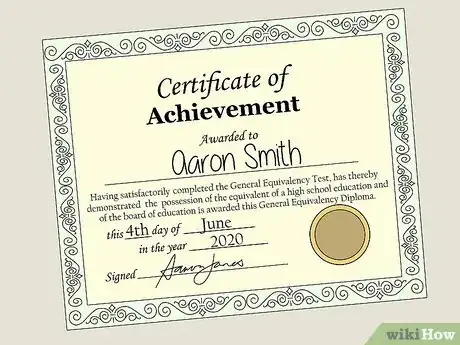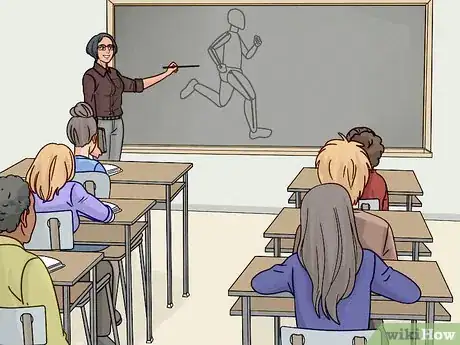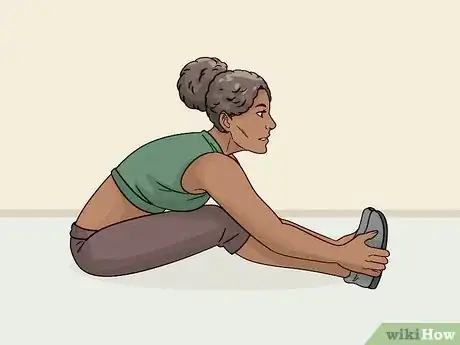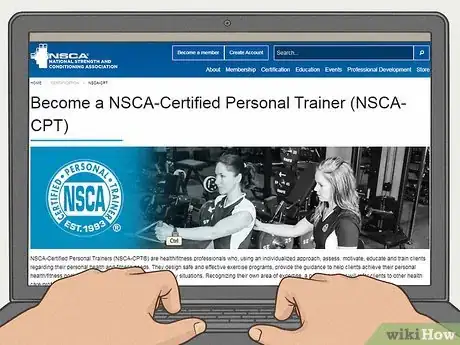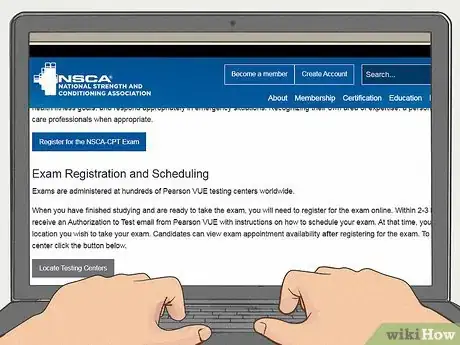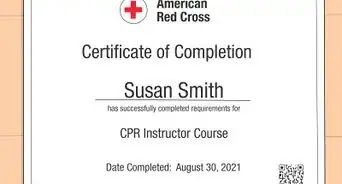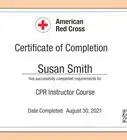This article was co-authored by Pete Cerqua. Pete Cerqua is a Certified Personal Trainer and Nutritionist. Pete is also a five-time best-selling author of books including "The 90-Second Fitness Solution" and "High Intensity Fitness Revolution for Women/Men" published by Simon and Schuster and Skyhorse Publishing. Pete has over 20 years of personal training and nutrition coaching experience and operates the 90-Second Fitness flagship studio in New York City.
There are 11 references cited in this article, which can be found at the bottom of the page.
wikiHow marks an article as reader-approved once it receives enough positive feedback. This article received 15 testimonials and 100% of readers who voted found it helpful, earning it our reader-approved status.
This article has been viewed 649,516 times.
If you're passionate about working out and helping others achieve their fitness goals, consider becoming a certified personal trainer. It’s one of the fastest growing professions, and for good reason. As a personal trainer, you can have flexible hours, do what you love every day, and inspire others to achieve their goals. To become a trainer, you’ll need to meet the basic eligibility requirements such as first aid certifications and the equivalent of a high school diploma. You’ll then be able to prepare for and take an exam offered by an accredited institution. After passing the exam, you’ll be a Certified Personal Trainer (CPT), ready to find work at a gym or branch out on your own.
Steps
Receiving the Right Education
-
1Earn a high school degree or an equivalent certification. In the US, this is the minimum education requirement for most certification programs. If you haven’t earned a high school diploma, work towards getting a high school equivalency diploma (HSED) or passing the General Education Development (GED) test.[1]
- Research the educational requirements for your country if you’re outside the US. Typically, you’ll be required to have successfully completed your secondary education.
- While you can start informally preparing before this point, you’ll need to reach legal adulthood (age 18 in the US) before you can enroll in an accredited personal training certification program.
-
2Get trained and certified in CPR and ADP. Take a first aid training course that offers certifications in cardiopulmonary resuscitation (CPR) and automated external defibrillator (ADP) use. These are prerequisites for most personal trainer certification programs.
- These skills will come in handy in the event that you need to help a client in a medical emergency.
Advertisement -
3Pursue a degree in a related field to expand your knowledge base. Look into a community college or 4-year university for a program that relates to your interests. You may consider programs and courses in kinesthesiology, exercise science, personal training, human anatomy, sports medicine, and nutrition. Work towards an associate’s or bachelor’s degree and tailor your studies to your goal to become a personal trainer.[2]
- A college degree isn't required for most CPT certification programs. However, postsecondary education can significantly increase your knowledge, skillset, and chances of success in the industry.
- You can also proceed to earn a graduate degree in your niche.
-
4Take a short-term personal training course to maintain a narrow focus. Look for a trade school or a community college that offers short-term CPT training programs. Research the training programs hosted by accredited agencies as well and make sure your program is focused on preparing you for the exam you’re planning to take.[3]
- Programs may be self-study, guided individual study, or guided group study.[4]
- The scope and timeframe can differ substantially from course to course, so make sure you understand the details before jumping in.
- For instance, a short-term course could involve a weekly session for 2 semesters, or it could be a 3-day intensive. The former is a better choice for someone just starting out, while the latter is a great idea if you just need some exam prep assistance.
-
5Attend a personal training school to immerse yourself in the industry. Personal training schools, which offer in-depth training over the course of weeks or months and help students prepare for certification exams, have become increasingly popular. If you’re completely new to the fitness industry, or you want to take a guided deep-dive into your training, this experience might be beneficial. Compare the costs and benefits of this type of program to see if it’s right for you.
- Note that these schools tend to be more expensive than other short-term certification programs.
- It’s not necessarily more beneficial to graduate from such a school in order to find a job.
- An example of a reputable personal training school is the National Personal Training Institute.[5]
Developing Essential Skills
-
1Gain knowledge in a variety of related scientific fields. During your studies, you should learn all about how the human body works. When possible, take classes in exercise science, human anatomy, human biology, kinesthesiology, and motor development to understand the mechanics of the human body.[6]
- These subjects will help you understand your clients’ bodies and needs and determine how to help them get as fit as possible while staying safe.
-
2Balance your theoretical study with hands-on training. You should know how to implement your theoretical knowledge in practical terms. Take workshops and courses that cover different exercise techniques, teaching and coaching skills, program planning, and nutrition. Consider what you might want to specialize in and focus your efforts in that direction.
- For instance, you might learn about resistance training and weight training for muscle building. Or you may want to learn about working with children or people with special needs.
- Personal training is a competitive business, and one way to help yourself stand out is by choosing a specialty and perhaps even receiving additional certifications.[7]
-
3Study business so that you can thrive as a fitness professional. Incorporate communication and leadership training into your coursework. Brush up on professional ethics as well as the legal necessities of developing contracts and running a fitness business. Study program planning to help you craft the best possible workouts and schedules.
-
4Develop empathetic leadership and communication skills. Conduct a formal study of leadership and communication through books and lectures. Then practice implementing these skills in your daily life. Aim to be an inspiring, trustworthy, and caring leader.[10]
- These skills will come in handy every day of your personal trainer career. After all, you’ll be leading clients through exercise sessions that may evoke physical or emotional discomfort, frustration and sometimes tears.
- Keep your clients focused on their goals and share in the satisfaction and happiness that comes with each achievement.
-
5Establish a fitness and wellness routine for yourself. Work on getting your own body into optimal physical shape so that you can demonstrate what it means to be fit and healthy to your clients.[11] Expect to train just as hard, or harder than your own clients throughout your own fitness journey.
- Even great educators and motivators may have trouble finding clients if they don’t seem to be in shape. While each body is different, clients expect that their trainers can healthily define and meet their own fitness goals.
- Consider hiring your own trainer to gain perspective on the trainer/client relationship. Observe how your relationship with your trainer develops and learn from their successes and failures. Just be up front about your intentions and avoid stealing what your trainer has shared with you.
Getting Certified
-
1Choose an accredited CPT certification program. If you’re in the US, look for a program that’s accredited by the National Commission for Certifying Agencies (NCCA). If you’re outside the US, research nationally accredited programs in your area. The organizations that provide certifications each concentrate in slightly different areas. Conduct research to decide which certification program seems like the best fit for you.[12]
- The 4 main US agencies that offer accredited CPT programs are the National Strength and Conditioning Association (NSCA), the National Academy of Sports Medicine (NASM), the American College of Sports Medicine (ACSM), and the American Council on Exercise (ACE).
- Other accredited US agencies include the National Council on Strength and Fitness (NCSF), the National Exercise Trainers Association (NETA), the National Strength and Conditioning Association (NSCA), and the Academy of Applied Personal Training Education (AAPTE), among others.[13]
-
2Register and prepare for the certification exam. Once you know which certification program you’re after, book a spot on your preferred exam day and pay the fee. Registration may cost between 200 USD to 500 USD.[14] In advance of your testing date, prepare with study guides and practice exams.
- Some short-term personal training courses include the exam as part of the curriculum and tuition.
- Consider following the training course or exam preparation program offered by the agency you’re getting certified through.[15] Many agencies offer online self-study options which can save you money.
-
3Sit for your certification exam. Get a good night’s sleep before your exam. Then, when it’s time to take your test, head to the testing location and follow the proctor’s directions. Don’t be too stressed out. If you’ve prepared well, this is a chance to show off what you know! Plus, it’s the last step you’ll need to take before becoming a certified personal trainer.
- Personal trainer certification exams are most often administered on the computer. They typically contain about 150 multiple choice questions to make sure you’re knowledgable in the fundamentals of fitness.[16]
- As an example, if you take the Certified Personal Trainer exam through the National Academy of Sports Medicine, you’ll work through 4 sections: “Program Planning,” “Client Consultation and Fitness Assessment,” “Exercise Techniques,” and “Safety and Emergency Issues.”
Finding Work as a Personal Trainer
-
1Find a job at a fitness center or gym. Look at job listings in your area and ask around about opportunities. If you’re already a member of a gym, let the administration know that you’re interested in working as a personal trainer. They might just have an opening! Consider working for a gym even if you plan to branch out later. A reputable employer can provide credibility when you’re first starting out.[17]
- If you worked at a gym before earning your certification, let your past colleagues know you’re newly certified and looking for work.
- Working at a gym will give you the chance to learn from other personal trainers and get practice working with a steady stream of new clients.
-
2Build a client portfolio. Whether you’re working at a gym or branching out on your own, start building good relationships with prospective and active clients as soon as possible. Think like an entrepreneur to boost your reputation and business.[18] Familiarize yourself with marketing basics and spread the word about what you’re doing.
- Personal trainers’ pay is commission-based, so the more clients you have, the better.
- Get active on social media to promote your work. Post pictures of your studio, and, with their permission, your happy clients.
- Keep in mind that your gym may require you to sign a non-compete agreement to prevent you from taking clients if you decide to leave.
-
3Start your own personal training business. Whether you choose to become a freelancer or open a small business, you’ll be able to set your own rate and keep all the money you earn. You’ll also get to pick the clients you work with. Learn what it takes to start a small business and follow the regulations in your state. Get personal trainer insurance, which is a legal requirement in many areas, before you start working with clients.[19]
- Make sure you understand all the complexities of running a business, such as the ins and outs of insurance, payroll, and taxes.
- Some personal trainers hold sessions in their homes, where they have a room set up with the proper equipment. If you do this, make sure the setting is clean, safe, and professional.
- Other personal trainers rent a studio, which they sometimes share with other personal trainers. This could be a more attractive choice if you have a large client list.
Additional Resources
Expert Q&A
-
QuestionDo you need to go to college to become a personal trainer?
 Michele DolanMichele Dolan is a BCRPA certified Personal Trainer in British Columbia. She has been a personal trainer and fitness instructor since 2002.
Michele DolanMichele Dolan is a BCRPA certified Personal Trainer in British Columbia. She has been a personal trainer and fitness instructor since 2002.
Certified Fitness Trainer No, the courses are provided by organizations such as the American Council on Exercise. Although you have to write assignments, tests and at least one exam, there is no college requirement.
No, the courses are provided by organizations such as the American Council on Exercise. Although you have to write assignments, tests and at least one exam, there is no college requirement. -
QuestionWhat qualifications do you need to become a personal trainer?
 Michele DolanMichele Dolan is a BCRPA certified Personal Trainer in British Columbia. She has been a personal trainer and fitness instructor since 2002.
Michele DolanMichele Dolan is a BCRPA certified Personal Trainer in British Columbia. She has been a personal trainer and fitness instructor since 2002.
Certified Fitness Trainer You have to take a course that is sanctioned in your state or jurisdiction. If you are interested, go to ACE - American Council on Exercise, to learn more about becoming a certified personal trainer.
You have to take a course that is sanctioned in your state or jurisdiction. If you are interested, go to ACE - American Council on Exercise, to learn more about becoming a certified personal trainer. -
QuestionDo you have to pay a rent for the certificate every month?
 Michele DolanMichele Dolan is a BCRPA certified Personal Trainer in British Columbia. She has been a personal trainer and fitness instructor since 2002.
Michele DolanMichele Dolan is a BCRPA certified Personal Trainer in British Columbia. She has been a personal trainer and fitness instructor since 2002.
Certified Fitness Trainer No. Any certification that requires a monthly fee is likely not credible. If you find a program like this, turn away.
No. Any certification that requires a monthly fee is likely not credible. If you find a program like this, turn away.
Warnings
- Be careful to avoid disreputable certifications. A proper certification should require several months of preparation and a proctored exam. Avoid sites that offer quick certification for under $100. Do your research and check the organization's credentials to make sure that their certifications are recognized.⧼thumbs_response⧽
References
- ↑ https://www.learnhowtobecome.org/personal-trainer/
- ↑ Pete Cerqua. Certified Personal Trainer & Nutritionist. Expert Interview. 30 June 2020.
- ↑ Pete Cerqua. Certified Personal Trainer & Nutritionist. Expert Interview. 30 June 2020.
- ↑ https://www.nasm.org/how-to-become-a-personal-trainer
- ↑ https://www.afpafitness.com/blog/what-are-the-key-differences-between-personal-trainer-certifications
- ↑ https://www.acefitness.org/fitness-certifications/ace-answers/exam-preparation-blog/3052/how-should-i-study-anatomy
- ↑ https://www.afpafitness.com/blog/what-are-the-key-differences-between-personal-trainer-certifications
- ↑ https://www.learnhowtobecome.org/personal-trainer/
- ↑ https://www.forbes.com/sites/benmidgley/2018/09/26/the-six-reasons-the-fitness-industry-is-booming/#2b69f5c4506d
- ↑ https://ceoworld.biz/2018/09/11/key-qualities-and-skills-required-to-be-a-personal-trainer/
- ↑ https://nrpt.co.uk/become/introduction/trainer-characteristics.htm
- ↑ Pete Cerqua. Certified Personal Trainer & Nutritionist. Expert Interview. 30 June 2020.
- ↑ https://www.learnhowtobecome.org/personal-trainer/
- ↑ https://www.learnhowtobecome.org/personal-trainer/
- ↑ https://www.nasm.org/how-to-become-a-personal-trainer
- ↑ https://www.learnhowtobecome.org/personal-trainer/
- ↑ https://careertrend.com/how-5849057-job-gym.html
- ↑ https://www.besthealthmag.ca/best-you/fitness/equinox-personal-training/
- ↑ https://nrpt.co.uk/become/introduction/index.htm
About This Article
Becoming a personal trainer takes time and effort, but you can do it with the right training and hands-on experience. You’ll need a high school diploma or the equivalent, as well as certifications in CPR and automated external defibrillator use. Once you meet those qualifications, join a short-term personal training certification program. Get familiar with the theory behind personal training by taking classes on subjects like anatomy and kinesthesiology, and also look for opportunities to get hands-on training. It’s also a good idea to build your leadership and business skills so that you can work well with clients and deal with the practical side of personal training. Additionally, spend time working out so that you’ll be in peak physical condition before you start training clients. For more tips from our Personal Trainer co-author, like how to get a job as a trainer, read on!
